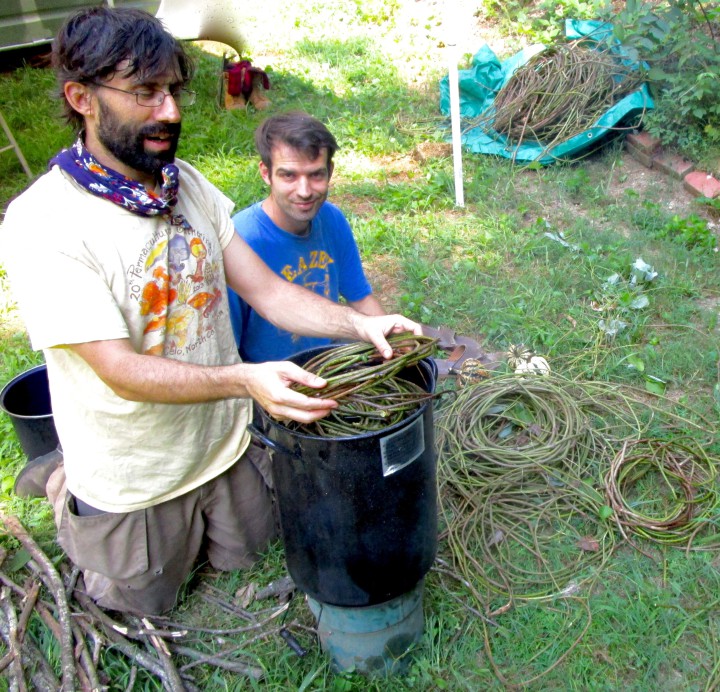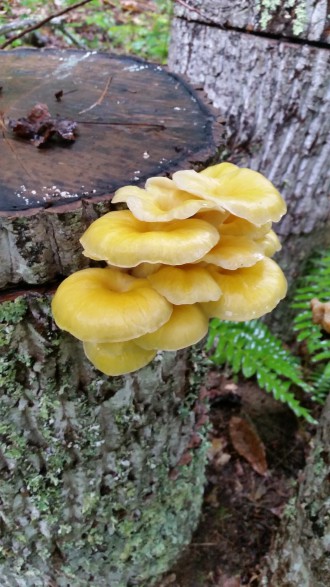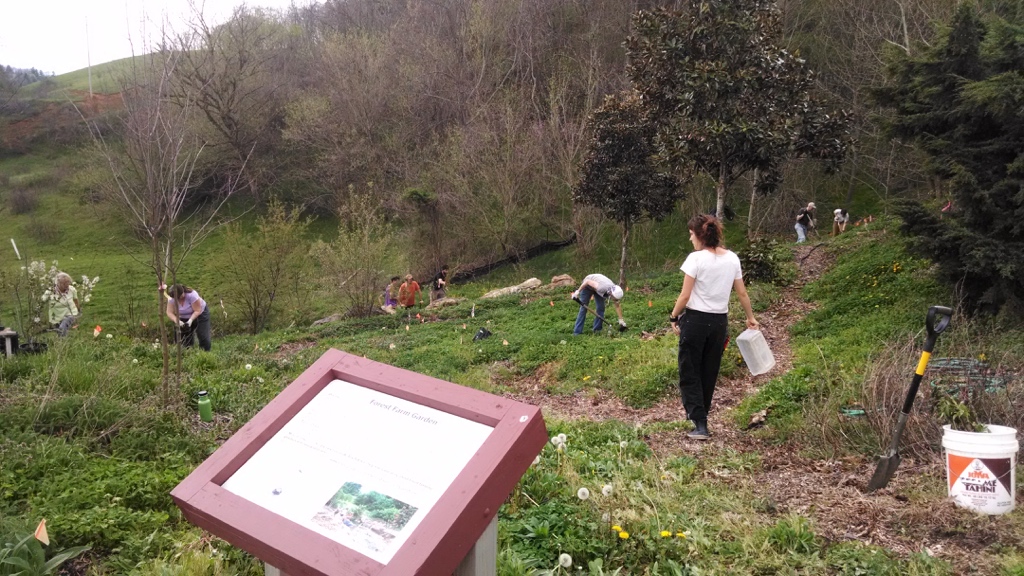Farming: For most of us, the word conjures images of geometric rows of vegetables, cows contentedly grazing in well-mown pastures, and carefully pruned and tended orchards bearing grocery-store-bin fruit. In Western North Carolina, however, that traditional image of farming is being met with an alternate view: of the cultivation of ginseng and other medicinal native plants, and apple trees replaced by chestnuts; of acorn gathering and even kudzu harvesting — all accomplished not in wide-open fields and pastureland, but beneath a wild forest canopy.
What is forest farming?
Forest farming, as this alternative agricultural practice is known, is defined as “the intentional cultivation or stewardship of plants with economic value under a forest canopy,” at ground level in established forested areas, according to Bristol, Va.–based U.S. Forest Service researcher Jim Chamberlain. Along with silvopasturing (raising animals in the forest), alley cropping (growing crops in rows between timber or nut crops), windbreaks and planting in buffer zones along waterways, forest farming is a component of agroforestry
While some local forest-farming practitioners may blur the lines among these categories when describing their agricultural practices, the bottom line, Chamberlain says, is that agroforestry cultivation methods can benefit both farmers and the environment.
Chamberlain, who studies and writes about non-timber forest products, became interested in agroforestry while serving as a Peace Corps volunteer in the Philippines, where he realized that other countries harvest more than timber and wildlife from their forested areas. On his webpage, Chamberlain writes, “Long before we had technology to cut timber, people were foraging forests for food, medicine and other sundry items. That practice continues today, yet very little is done to ensure that [these] harvests are sustainable.”
In Western North Carolina, Chamberlain explains, native crops such as ginseng, goldenseal, black cohosh and ramps benefit from forest- farming practices, which protect these valuable plants from over-harvesting and preserve both their quality and chemical profile. As well, he adds, forest farming tends to yield greater volumes of the plants than does wild harvesting.
Forest fan
Sylva native Zev Friedman is a passionate local advocate for sustainable agriculture. Through his Living Systems Design consulting practice and other groups, he teaches farming techniques that meet human needs while preserving and regenerating the natural environment. Friedman says forest farming is a natural fit with the topography and the native plants, animals and fungi of Western North Carolina.
The ultimate goal of forest farming, Friedman maintains, is to easily manage forested areas to get the highest yields for the least work while maintaining the health of the system and playing to the natural tendencies of the organisms involved. He points to traditional practices like the milpa crop rotation system of Mesoamerica as a model that can inform modern approaches to sustainable agriculture. According to Living Systems Design’s website, the milpa system produces many different annual crops planted together in clearings rotated through a forest ecosystem over time. After seven to 15 years, a planting area is allowed to return to a forested state, which preserves topsoil and biological diversity.
Friedman is also working to find productive uses for plants present in WNC, even those that are invasive species imported from other places. Japanese knotweed, for instance, is showing promise as a botanical source for a possible treatment for Lyme disease, he notes. And in a TEDx talk last year, Friedman spoke about kudzu, which was originally brought to this country from Japan to control erosion, and has taken over 7 million acres in the Southeast. Yet, while the vine can cover and kill other trees and plants, it does have some redeeming features, he explained: The plant fixes nitrogen in the soil, and it loosens packed soil and breaks up subsurface rock.

At his Kudzu Vine Camp, in Sylva, Friedman demonstrates kudzu’s usefulness by teaching methods for harvesting the plant for fiber, food and medicine.
Demonstration project
Friedman has also been busy collaborating with the Friends of the Madison County Library and the Marshall Native Garden Initiative to create a demonstration Forest Farm. The farm, which has been in development since 2012, is located at the main branch of the Madison County Library, at 1335 N. Main St. in Marshall.
The site of the Forest Farm was originally covered with invasive plant species and dead wood. The land was cleared with a controlled burn (carried out by Marshall firefighters as a training exercise), and today, young nut-bearing trees such as chestnuts and hazels are becoming established, as are blueberries and other species of shrubs that will help prevent erosion. In the sunlit spaces between the trees, volunteers plan to plant annual food crops.
According to Rachell Skerlec, the volunteer champion of the demonstration project, plant succession planning — which takes into account changing conditions as upper-story plants grow and mature — is a critical part of forest farming. “As things start to grow up,” she explains, “you lose some of the ability to do those [annual] garden crops, but now you’re starting to have other crops available to you … which can be used for various purposes.” When trees and shrubs grow large enough to begin blocking light at the ground level, she continues, farmers introduce woodland plants that will thrive in shady areas, like aronia, ginseng and goldenseal.
The demonstration farm will provide many opportunities for educating visitors on the possibilities of forest farming, Skerlec says. Tags will identify individual plants, while a brochure will provide additional information about plant species used in the project. The Friends of the Madison County Library and the Marshall Native Garden Initiative plan on offering both fall and spring classes on forest farming on site, and volunteers can get hands-on experience during monthly volunteer workdays as the farm is developed and maintained.
A Glorious reawakening
Osker Brown established Glorious Forest Farm in 2012 on 100 acres in Madison County. According to the farm’s website, the operation strives “to work with the rich plants already living in our region, while carefully introducing appropriate plants and animals to instigate a new sacred cuisine.”
In bottomland previously used for growing annual crops, Brown has planted hazelnut and mulberry trees. While waiting for those trees to mature, Brown uses the area between the trees for pasturing pigs. The animals feed on plants that are generally considered weeds, he says. However, not everyone agrees with the practice. Although it has a long history in Appalachia, U.S. Forest Service’s Chamberlain explains, pigs can destroy native plant species along with invasive weeds, and they can cause erosion by rooting in and displacing the soil.
Brown has also discovered a good use for the tulip poplar. The fast-growing tree, which is abundant in WNC, doesn’t produce much food for humans or animals, but it is a prolific pioneer that takes hold after land has been cleared, thereby preventing erosion. As well, once they reach an appropriate size, the trees can be cut, and Brown then uses their stumps as a medium for growing mushrooms. The mushrooms provide a food or cash crop, and the cut trunks of the trees decompose into material that will enrich the forest floor. More desirable tree species, such as hazelnut and chestnut, can then be planted in spots where the forest floor has been opened up to sunlight.

Brown especially prizes oak trees for their acorns, which can provide a food source for people and livestock. He teaches workshops on the process of turning acorns into flour, and he also shares detailed tips on his website, www.gloriousforestfarm.com.
Glorious Forest Farm uses pruning techniques that manipulate trees’ growth to create higher yields or other benefits. For instance, Brown cuts the trunks of mulberry trees to the ground to allow shoots to grow from the roots — a practice known as coppicing. The mulberry trees then grow in a bush form, which makes gathering leaves and berries more manageable. Coppiced trees can also yield firewood or building material. Using the shoots from a coppiced tree as firewood reduces labor since the wood does not need to be split.
Future of forest farming
“We do a tremendous job managing forests for timber and wildlife, but we do very little to manage those same forests for food or medicine,” Chamberlain writes on his website. “Forests are more than trees! To manage for biodiversity, we must consider the understory vegetation that is harvested for subsistence and commercial gain.”
Since interest in forest farming is still in its infancy in this country, Chamberlain and other experts, including Friedman, believe the field offers lots of potential. As farmers and communities find new ways to combine forest conservation with commerce, writes Chamberlain in an article for the Cooperative Extension Service, they will discover opportunities to grow food, rebuild soils, restore aquifers and mitigate the effects of floods and droughts.
And that is farming well worth imagining.




Before you comment
The comments section is here to provide a platform for civil dialogue on the issues we face together as a local community. Xpress is committed to offering this platform for all voices, but when the tone of the discussion gets nasty or strays off topic, we believe many people choose not to participate. Xpress editors are determined to moderate comments to ensure a constructive interchange is maintained. All comments judged not to be in keeping with the spirit of civil discourse will be removed and repeat violators will be banned. See here for our terms of service. Thank you for being part of this effort to promote respectful discussion.